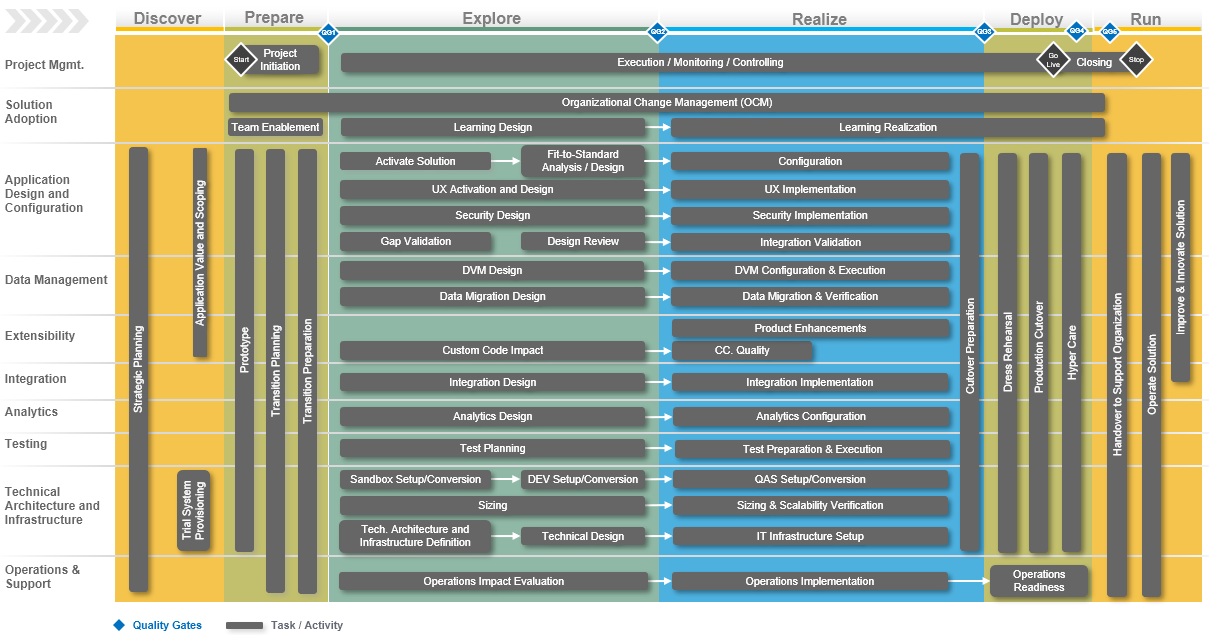
In today’s digital age, efficiency in implementing or upgrading business solutions is critical. Businesses need robust methodologies to streamline processes and maximize return on investment. One such method is the SAP Activate Methodology, a framework designed to accelerate the implementation or upgrade of SAP solutions and ensure that projects are successful, efficient, and smooth. In this SC Silver article, we take a closer look at the SAP Activate Methodology and what it means for organizations.
Explore the extensive resources available on SC Silver to delve deeper into SAP and increase your understanding. Whether you are a seasoned professional seeking advanced insights or a newcomer looking to grasp the basics, SC Silver offers a wealth of information to suit different levels of expertise.
What is the SAP Activate Methodology?
The SAP Activate methodology is an agile and iterative approach to implementing or upgrading SAP solutions. It combines proven best practices, accelerated solution journeys, and design thinking techniques. It is designed to help organizations deploy SAP systems faster by streamlining the implementation or upgrade process (improving and optimizing business processes, also relevant now for the S/4 migration), accelerating time-to-value and reducing overall costs. How to implement or upgrade SAP solutions more easily in the future: Follow the methodology’s roadmap.
The 6 phases of the SAP Activate Methodology

The SAP Activate Methodology is divided into several phases that cover the entire implementation or upgrade cycle. Key phases include:
1. Discover Phase:
The Discover phase marks the beginning of the implementation or upgrade journey. Stakeholders work closely together to identify business objectives, challenges and opportunities. Through workshops, interviews and assessments, the project team gains a comprehensive understanding of the organization’s current state and future aspirations. This phase lays the foundation for the rest of the implementation or upgrade process and guides subsequent decisions and actions. During the discovery phase, customers learn about the benefits of SAP HANA and SAP S/4HANA and the positive impact they can have on their business.
2. Prepare Phase:
This phase includes defining the project objectives, assembling the project team, and setting up the project infrastructure. It also assesses project opportunities and challenges to develop a clear implementation or upgrade roadmap. Prior to the actual transition project, customers typically initiate prototype projects to assess technical and functional feasibility, which last between three and six months. This is followed by the formal project setup, which is coordinated with the customer’s project manager and typically follows a defined methodology, such as SAP Activate. change management activities are outlined and project team enablement begins. If not already done, an SAP S/4HANA readiness assessment is performed on the SAP ERP system to identify potential impacts on the transformation project. High-level project planning is performed in workshops, Considering the results of the discovery phase, such as the functional implementation or upgrade roadmap. Preparatory activities identified in the planning workshops are addressed before entering the Explore phase, which requires detailed planning within the Project Management workstream.
3. Explore Phase:
During this phase, the company’s requirements are analyzed and suitable SAP solutions are identified. This includes workshops to understand the business processes and prepare the configuration of the SAP solution. The Explore phase of the SAP Activate methodology is critical to project success. During this phase, customers finalize their business processes for the new SAP system through Fit-to-Standard analysis sessions that showcase SAP best practice business flows. The goal is to define key deliverables such as migration templates and execution of standard processes. Customer requirements, including additional objects and configuration values, are documented in a backlog that is signed off by stakeholders. Fit-to-Standard analysis is performed through workshops to validate predefined scenarios, requiring project teams to be familiar with SAP Best Practices content beforehand.
4. Realize Phase:
This phase involves the actual configuration and customization of the SAP solution according to the identified requirements. Prototypes are created and continuous feedback is gathered to ensure that the solution meets expectations. The SAP Release phase aims to configure SAP systems based on the signed backlog document from the Explore phase. Project teams work in planned sprints, breaking down requirements into manageable deliverables, which are then reviewed and approved by the business process owner.
5. Deploy Phase:
During this phase, the implemented SAP solution is deployed in the production environment. Training is provided to prepare users for the new solution, and testing is performed to ensure smooth operation. Application design and configuration activities are completed with integration validation. Testing continues and extensibility remains inactive. Final rehearsal, implementation or upgrade of productive SAP S/4HANA takes place, with Q4 Deploy-to-Run ensuring readiness. “Hyper Care” stabilizes the system post go-live. The transition project ends with the operational handover to support.
6. Run and Adoption Phase:
The final phase is the operational management of the SAP solution. Ongoing enhancements and maintenance are performed to ensure that the solution operates optimally and meets the changing needs of the business. This phase marks the end of the customer’s lifecycle, from identifying the right solution for their business needs to implementing or upgrading the solution and running business processes as required. The implementation or upgrade strategy can now be reviewed and enriched based on the experience of using the system in the first weeks after go-live.
Roadmap Viewer and SAP Activate Methodology
A key enhancement introduced with the SAP Activate methodology is the Roadmap Viewer. This tool provides users with a comprehensive view of the implementation process and is part of every SAP S/4 migration, enabling them to better plan, track, and manage the project. SAP users or SAP consultants have the option to download documents or presentations for training purposes. The Roadmap Viewer integrates various SAP Activate deliverables, accelerators, and best practices into a single, easy-to-access platform that facilitates collaboration between project teams and stakeholders.

How SAP Activate Methodology Differs from its Predecessor
Compared to its predecessor methodologies like ASAP (Accelerated SAP), the SAP Activate Methodology offers several advancements
Benefits of the SAP Activate Methodology

The SAP Activate methodology provides several benefits to organizations, including
Bottom Line
The SAP Activate Methodology is a powerful tool for organizations implementing or upgrading SAP solutions and enhancing existing business processes and is part of every SAP S/4 migration. Its agile and iterative approach enables organizations to accelerate their implementation or upgrade projects, minimize risk and ensure that their solutions meet their needs. By combining proven best practices, accelerated solution prompts, and design thinking methodologies, the SAP Activate methodology provides a clear roadmap for the successful implementation or upgrade of SAP solutions.
At SC Silver, we offer expert SAP support and SAP services to help businesses in successfully implementing or upgrading SAP solutions. Consult with our SAP consultants to transform your business TODAY.





